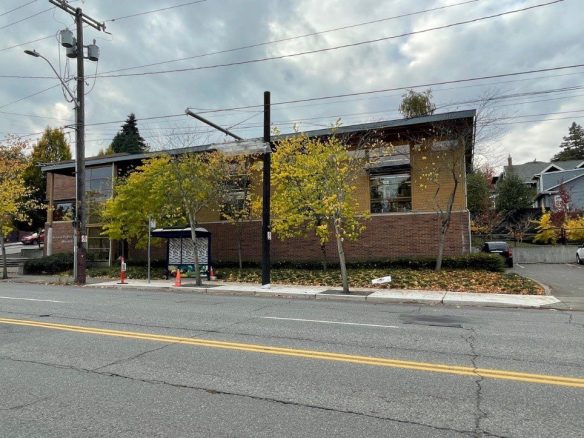The Seattle Department of Transportation and director Greg Spotts have put a bow on six years of work to complete a more modest than originally planned road diet of the 23rd Ave/24th Ave corridor north of Madison into Montlake that was cut back over the years from a transformation of the two lane configuration of the busy street.
The corridor provides access to the Montlake neighborhood, SR 520, the Montlake Bridge into north Seattle, and parts of Capitol HIll and the Central District to the south and serves as a key transit route. The completion of the project comes as Montlake’s connections to 520 are still being rebuilt and a new freeway lid is under construction as part of the state highway’s long-running replacement project.
But unlike the corridor’s overhaul to single lane traffic south of Madison, SDOT backed off a similar reconfiguration through Montlake meaning residents and pedestrians must today still cross four lanes of traffic to move through the neighborhood even after the years of work.
SDOT tackled the 23rd Ave/24th Ave overhaul in three phases. The third and final phase of the project from E John to E Roanoke has now been completed, SDOT said this week. During this phase, improvements were made at the intersections at E John and E Lynn, including repairs to sections of sidewalk and the installation of new accessible curb ramps. Additionally, bus stops were upgraded and painted curb bulbs and posts were installed to improve visibility and safety for people walking and rolling.
We installed these safety features at E Louisa St and Turner Way E to help increase visibility of people walking, biking, and rolling, and decrease the distance they need to travel to get across the street. By adding these curb bulbs, we have also straightened vehicle lanes which helps reduce speeds of people driving through the intersection — SDOT
These improvements are expected to reduce the opportunities for collisions and make people walking and rolling more visible to drivers, SDOT says. The materials used in the project are also designed to prevent cars from skidding in wet and slippery conditions.
The project is part of SDOT’s Vision Zero program and its 2030 deadline to make Seattle’s streets fully safe. Time is, of course, running out.
In April 2018, CHS reported on the start of work on the much more intensive construction and overhaul of the street in the Central District south of Jackson. The first phase of the project between John and Jackson streets took 21 months to complete.
Montlake’s diet was much less intense. Transportation officials backed off more aggressive plans for new bus lanes in the northern stretch of the overhaul and also responded to the neighborhood’s business community by maintaining street parking along the road — though funding was not available to complete the full Montlake Community Business District Improvement Project vision championed by local merchants.
The biggest change in the third phase appears to be well south of Montlake at 23rd and John where SDOT finally overhauled one of the city’s most dangerous intersections for red-light crashes last year.
Meanwhile in Montlake, though improvements include new crossings, curb bulbs, and safety features, the river of cars still flows through the area much like it did when the project began six years ago.
520 and the new Montlake Lid construction continues and seem unlikely to reduce that flow anytime soon.
“This project is an important part of SDOT’s Vision Zero program to end traffic deaths and serious injuries on city streets by 2030,” SDOT said in its announcement of the last work on the 23rd Ave and 24th Ave overhaul. “Still, we have significant work ahead to continue designing a safer transportation system – one that takes into account our shared imperfection as human beings, so that if a bad crash does occur, it doesn’t result in death or serious injury.”
 PLEASE HELP KEEP CHS PAYWALL-FREE!
PLEASE HELP KEEP CHS PAYWALL-FREE!
Subscribe to CHS to help us pay writers and photographers to cover the neighborhood. CHS is a pay what you can community news site with no required sign-in or paywall. Become a subscriber to help us cover the neighborhood for as little as $5 a month.







We lived on Helen Street and 25th down the extremely steep grade hill towards the arboretum. In the 1970’s the City of Seattle wanted to divert all west bound traffic on Madison going uphill to Helen Street and up to 24th. We had an open house for neighbors and City engineer. During the meeting a car stalled out coming up the hill and we could hear the desperate motorist trying to get up the hill. We skied it when we had snow.
Clearly Vision Zero doesn’t care anything actually building an efficient road system, it artificiallly created constant traffic congestion on 23rd and Union by refusing to add left-turn only and right-turn only lanes.
A city of incompetency.
There are left-turn only lanes in every direction at 23rd/Union.
The lack of crosswalks north of John on 23rd are kind of ridiculous. Republican barely counts because it isn’t a through street. 10th Ave E north of Galer has the same issue, and there’s even attractions there (Streissguth Gardens at 10th and Blaine, Howe Street Steps at 10th and Howe)
The road slimming south of Union is awesome, transformative. Where before cars sped by just a couple feet away on the 4 lane 23rd, now with 3 lanes there are curb strips that provide a nice buffer, and cars don’t speed as previously. 23rd is actually walkable again on that stretch. Well done!